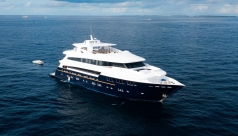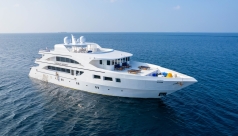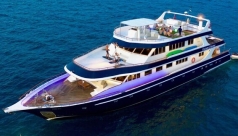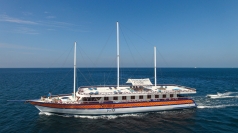Dive Destinations
Liveaboards
Resorts / Day Trips
Scuba Training
As the airplane descends towards the azure expanse of the Indian Ocean, anticipation electrifies the air like a current. A hushed awe falls over the passengers as the window reveals the ethereal beauty of the Maldives, a paradise of turquoise waters punctuated by emerald islands. With each passing moment, the heart quickens, eager to plunge beneath the surface into a realm where gravity seems suspended, and time slows to the rhythm of the tides.
Welcome to Gan Island, where the siren call of adventure beckons, promising encounters with lively coral gardens, elusive marine giants, and a kaleidoscope of underwater wonders waiting to be discovered.
With excited anticipation I was hoping for a memorable experience onboard the Emperor Voyager Explorer with these elusive marine animals. The deep south of the Maldives didn’t disappoint. The most notable dives were: the tiger shark experience where we spotted at least 8 individuals close up; another where we were surrounded by loads of black tips, spinners and grey reefs; one where 13 manta rays got very friendly at a cleaning station; another where there was a wall of around 70 grey reef sharks on a channel dive; and finally, on a single dive where we saw a tiger, oceanic manta, a group of hammerheads, some silver tips, a thresher and a whale shark - how do you beat that!
• Watch our Maldives Deep South diving video
At 99' (30m) long it comfortably fits 20 guests in 10 air-conditioned cabins. This was an average specification boat by Maldives liveaboard standards, so the look-and-feel wasn’t luxurious, but it was adequate. The boat had a full complement of passengers (16 divers and 4 non-divers), but it never felt too busy. In the evening you could chill in the lounge or on the top deck.
The indoor saloon is perfectly comfortable with sofas arranged around a few tables. There are lots of areas to sit and chat, play card games or view and edit photographs. The bar serves cocktails, Lion beer, gin & tonics, and soft drinks. There's a happy hour from 6 to 7pm every evening. You get 2 for 1 on cocktails (USD 10), or 2 for 1 on beers (USD 5.50). There’s an automatic 10% service charge added to your bill.
Wi-fi was available and worked most of the time. You get a 5 GB allowance for USD 30. Some chose not to connect to get away from it all. The saloon didn’t have air con but did have windows that opened and lots of fans and this was adequate for when I was there (March). There was a large library of fish identification books and a few fiction books you could borrow or swap.
• Watch our Emperor Voyager liveaboard video
The cabins were mainly adorned with dark wood fixtures and fittings, with a small en-suite. My cabin was equipped for 2 people. The cabin was quite roomy compared to others I’ve been on. As usual, not a lot of space to store suitcases so a few people left them in the hallway outside their rooms. I shared a cabin with a lovely guy from England. He was a quiet sleeper and only slept 4 to 5 hours a night. You never know when you travel alone who you’re going to get partnered with, so I was very lucky.
The rooms were cleaned and tidied everyday while you were diving. However, there were numerous occasions where guest complained about the smell from the en-suites. The staff did their best to rectify this, but it was never properly sorted. They tried to help by hanging air fresheners in the toilets to mask the smell. Many guests stopped using their own en-suites and used the communal toilets instead. Hopefully they’ll get this sorted before the next guests arrive.
The air conditioning had to be left on for 24 hours a day due to the humidity and the fact that it was a wooden boat. You could tell that the boat was suffering from high humidity as some guests reported mould growth in their cabins. You didn’t need to have it on cold, merely on running to take the moisture from the air. Some of these worked better than others, but they were generally pretty quiet compared to others I’ve experienced.
The rooms are generally quite dark due to most having just 1 small porthole window, but there were plenty of lighting options to brighten the bedroom.
The dining area was arranged around 1 long table and a second smaller one. It was buffet-style, where you helped yourself to as much as you wanted. The food was generally enjoyed by the guests. It was hearty food and not too spicy. However, there were times when food ran out, so get there quick as it wasn’t replenished. Those with special food requirements (e.g. vegan, vegetarian) were catered for. I’m a vegetarian and there was always plenty for me. They also made a small compote of vegetables to accompany every meal. One guest was severely allergic to garlic, so they pointed out what was suitable for her.
At breakfast (8 am after the first dive) you can expect a small selection of hot and cold foods, pancakes, fruit, omelettes, chocolate pastries, and toast. They collect your egg order everyday so you can have them just the way you like.
At lunchtime (2 pm) there was a selection of hot and cold foods that was similar to what you’d get for dinner. It was enough to keep you going. The table served free and limitless amounts of fruit juice and water.
Throughout the day there was unlimited tea (black, green, mint, lemon and Earl grey), filter coffee (very strong), cold water, and biscuits. After most dives there was a slice of sponge cake and a fruit juice waiting for you as soon as you departed the dhoni.
Dinner was served at 7 pm. Typically you’d have coleslaw, salad, rice, pasta, noodles, grilled vegetables, grilled white fish or calamari, and a meat dish. The meat was usually chicken in a smoky BBQ sauce (drumsticks, skewers), but occasionally lamb or beef. The first drink of wine was free, then you paid for the additionals. Fish lovers will appreciate that the fish were caught the previous evening directly from the boat.
The deep south liveaboard route covers 3 atolls: Huvadhoo, Fuvahmulah and Addu. Most of the diving was done around Huvadhoo. There’s not a huge amount of travelling between atolls, so most of the time the boat is just situated off the atoll and the travelling is by dhoni.
The main draw of this area is the large marine life. And I can say that it didn’t disappoint. It’s also worth noting that there is an abundance of other life too; tuna, shoals of jacks and wahoo, moray eels, bump-head parrotfish, triggers, octopus, spiney lobster, nudibranchs, plus much more. It is fair to say that this area is teaming with life.
Most of the dives have some current and there are a many channel dives where you hook on and enjoy the show. Every dive had sharks and green turtles. You always saw white tips and grey reefs, it was rare to see hammerheads, even rarer to see tigers. We saw a ray on most dives, typically eagle or reef manta, but there were also oceanic mantas and the odd mobula or feathered sting ray.
We did spot spinner dolphins showing off from time to time from the boat and heard them clicking in the water, but we weren’t fortunate to spot them under the waves.
The itinerary for the week was:
Day 1 - Boarded the yacht at 12 pm and chilled until the rest of the party arrived. Due to some late arrivals, we had to change the route slightly to collect them at 2 am the next morning.
Day 2 - Met fellow divers, staff, and had various dive and safety briefings. Had the check dive and 2 others around Huvadhoo.
Day 3 - Huvadhoo
Day 4 - Huvadhoo
Day 5 - Fuvahmulah
Day 6 - Addu (1 morning dive)
Day 7 - Left the boat at 7 am. Some customers left at 2 am to catch an earlier flight.
The dive manager gave an excellent safety briefing on the way to the first dive site. This included a detailed explanation about the process, deco chamber, etc. One sobering thought, a sea-plane evacuation is USD 35 000, and the deco chamber could cost USD 20 000 or more, depending on the severity. So, ensure your dive insurance covers this.
The deck was very well organised and there was plenty of room to manoeuvre. The dive leaders took the nitrox readings and you signed acknowledgement. There was one large freshwater tank for cameras and computers, and another for rinsing everything else. The dhoni had 2 showers at the back with lukewarm water. There was one communal toilet, and it was kept very clean throughout the week. You were given a fresh towel for the day to use on the dhoni.
Since we had 16 divers (American, English, Dutch, and German) we were split into 3 groups. We would transfer from the Explorer to the dhoni, transit to the site and then all jump at the same time from 3 different exits.
Entry was by stride-entry, and there were no negative entry dives. If there was a current, then they would jump up-current so there was time to drop and get to the site.
The dive duration was a maximum of 50 minutes. This was more than enough time as all dive sites were in the 20-30m range. The policy was a max depth of 30m and no deco stops. Each diver had to carry their own SMB.
The dive boat staff were very attentive and helpful. You weren’t hanging around at the surface for long before they spotted you and rushed over. Then taking it in turns, you handed over your fins before climbing up the ladder. When back to the dhoni, your fins were already under your seat, and you just needed to de-kit yourself.
There was only one dusk dive (no night dives) and at certain times you’ll be asked to not use any torches or flashes due to startling certain wildlife like hammerheads and tiger sharks.
The dive staff had a novel approach to engaging with the guests. They generally did a very good job guiding the dives and pointing out animals of interest. But once back on the boat it was a very distant relationship. Perhaps they didn’t want to interfere with the guests’ camaraderie, as they were never seen or heard unless looked for. They were never present during the meals, and it was usual for them to not even say good morning or good night. It wasn’t an approach that was appreciated by the guests, so perhaps it’s something that can be reviewed by the company.
The staff also had a ‘shoulder shrug’ attitude, or ‘it is what it is’ response. I appreciate you can’t solve some of the problems while out at sea, but some empathy goes a long way. Perhaps a more ‘can do’ approach could be adopted to meet the customers’ expectations.
Once you arrive in Male (capital of Maldives) you’ll need a connecting flight to Gan Island. This takes about 1.5 hours. When you land there, you make your way to the mini harbour, about a 3 min walk from the airport, where you wait for the dhoni. There's a cafe, toilets and lots of seating if you get there early. You’ll be collected at 12 pm lunchtime.
Once you get on board the staff will do the paperwork. They'll request your passports, dive insurance (they want to see the actual certificate), dive qualifications and nitrox certificates (all dives except the first use nitrox) before departure. Once that's done you can make your way to your cabin and settle down. As it was just 2 pm, the divers that had arrived just chilled on the boat and waited for the rest to arrive.
It was early March, and the air temperature was about 30C during the day and hardly dropped in the evening. No one required long sleeves at night. As you’re on the equator it’s very easy to get sunburned. The sun is intense from 10 am to 4 pm, so take care.
Water temperate varied between 28 and 30C. Most divers wore shorties or even less (T-short and shorts). You weren't allowed to wear gloves. We did experience thermoclines on lots of dives so those that had a 5 mm full wetsuit were feeling rather smug.
Don't be surprised if visibility is down to 10m at times. However, on most dives the visibility was around 20 to 30m.
Currents can be quite strong so it's worth doing some swimming training to help build up some stamina. I know you don't normally swim against the current, but there are times when you need to put your head down and push through.
The Emperor team can arrange for accommodation once you leave the boat at 7 am. This is useful if you have a later flight that day. You'll stay at the local Equator village. You can choose a discounted price for 6 hours, and that gets you a room, shower, and the use of the pool. If you want to have the room for longer then you'll pay full price for the day. Double check with the Emperor team what they've booked for you as mistakes can (and did) happen and it could add USD 100 to your bill.
If you're a lover of sharks then this is the place for you. Every dive you'll see sharks, with a smattering of turtles, rays and schooling fish. Greys, blacktips, and white tips are a common sight. There's always a good chance you'll see some of the larger pelagics too. Mantas are common, and there's always a good chance of seeing whale sharks, hammerheads and tiger sharks. For those that like the variety of fish life, the deep south won't disappoint either - the reefs are full of life and can entertain photographers for hours.
The diving here can be challenging. There are a lot of different currents in the channels. Expect up, down and washing machine action at times. Most dives have some current, and some will astound you with their force. But just go with the flow. Take it as it comes and enjoy it. After all, you're on holiday.
Finally, a word about the staff of the Emperor Voyager liveaboard. They were professional in their approach and knowledgeable of the area. The barman (Nuwan) proved to be the most popular and friendly person on the boat. The dive leaders (Russ, Katy and Rowan) did an excellent job dive leading and pointing out animals of interest. It would have been nice if they had engaged more with the guests on the boat, but it would seem they preferred to keep a professional distance from the guests, perhaps they didn't want to intrude. A big thanks to the dhoni driver (Asley) and the crew (Jamal and Tara) who helped us in and out of the water. They must have been tired at the end of the day.
One of the customers was a part-time fireman and did an inspection of the boat. There were some serious issues raised that were passed on to the owners. For example, all fire extinguishers were out of date and escape hatches/corridors were blocked. The boat owners were grateful to receive this feedback and have since taken action to improve their processes and educate their staff.
Written by Elliott Hey, March 2024
(photos courtesy of Jeannie Tan)

Customer rating: Very good!

Customer rating: Good

Customer rating: Good

Customer rating: Good

Customer rating: Average

Customer rating: Excellent!

Customer rating: Excellent!

Customer rating: Excellent!

Customer rating: Excellent!

Customer rating: Excellent!

Customer rating: Excellent!

Customer rating: Excellent!

Customer rating: Excellent!

Customer rating: Excellent!

Customer rating: Excellent!

Customer rating: Excellent!

Customer rating: Excellent!

Customer rating: Very good!

Customer rating: Very good!

Customer rating: Very good!

Customer rating: Very good!

Customer rating: Very good!

Customer rating: Very good!

Customer rating: Very good!

Customer rating: Very good!

Customer rating: Good

Customer rating: Good

Customer rating: Good

Customer rating: Average

Customer rating: Below average

Customer rating: Be first to rate!

Customer rating: Be first to rate!

Customer rating: Be first to rate!

Customer rating: Be first to rate!

Customer rating: Be first to rate!

Customer rating: Be first to rate!

Customer rating: Be first to rate!

Customer rating: Be first to rate!
Listened to my particular needs and identified a superb value holiday. Organised all the little stuff, without complaint. Thank you so much for all you organising. It was a fantastic trip and if I am ever doing this again I will certainly contact you.
